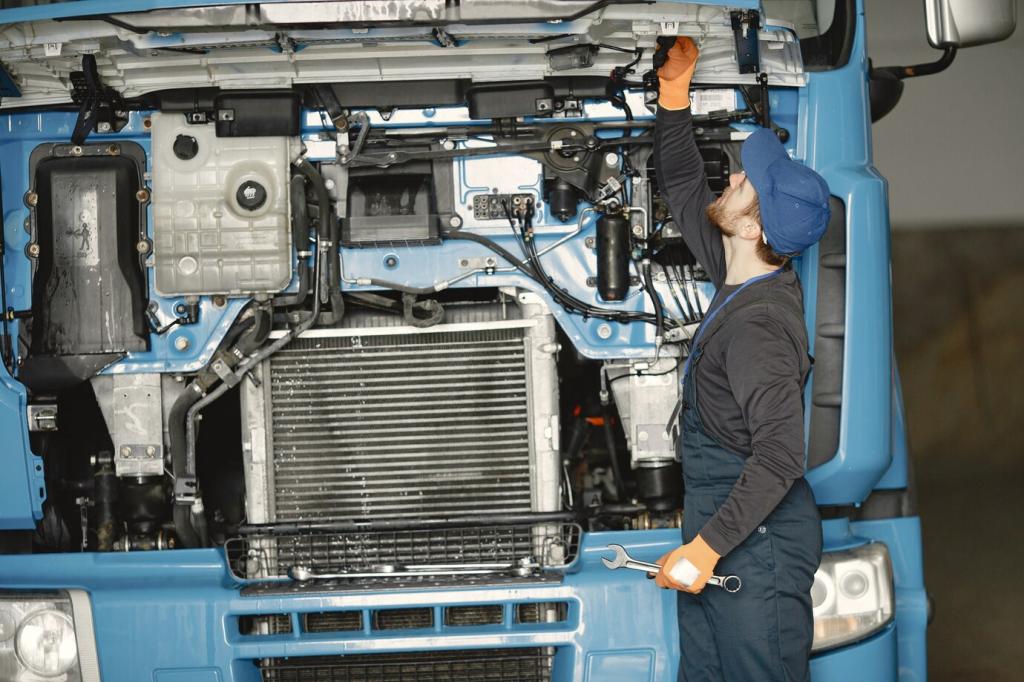Chosen theme: DIY Maintenance Tips for Small Fleet Owners. Keep your vans, pickups, and box trucks reliable with practical, hands-on routines that fit tight schedules and tighter budgets. Subscribe for weekly checklists, share your toughest maintenance moments, and help fellow owners keep wheels turning without drama.


Preventive Maintenance That Actually Sticks
Map factory intervals against your actual duty cycles, then color-code each vehicle’s calendar by month. A shared wall planner plus a simple spreadsheet beats memory, prevents collisions, and invites drivers to participate. Post the plan where keys live and accountability grows.
Preventive Maintenance That Actually Sticks
Keep duplicates of consumables that stop work: wiper blades, bulbs, fuses, hose clamps, crush washers, nitrile gloves, and shop towels. A torque wrench, fluid pump, scan tool, and low-profile jack turn parking-lot fixes into calm wins. Label bins to reduce frantic searching.
Fluids and Filters: The Lifeblood of Your Fleet
Oil Choices and Intervals That Fit Mixed Duty
Blend factory guidance with route reality. Short trips and idling justify shorter intervals; highway miles stretch them modestly. Choose viscosity by climate and spec—5W-20, 5W-30, or 0W-40 where appropriate. Used-oil analysis reveals fuel dilution, wear metals, and confirms decisions with data.
Coolant: Test, Don’t Guess
Use a refractometer or test strips to check freeze protection and pH. Stray voltage from poor grounds can eat radiators, so measure for electrolysis and fix grounds immediately. Record coolant type by VIN to prevent mixing formulas, then schedule flushes before corrosion takes root.
Air and Fuel Filters Under Dusty Routes
Dusty construction runs clog filters fast. Fit a restriction gauge on air boxes, consider pre-filters, and inspect snorkels after storms. Drain water separators routinely on diesels. Consistent, date-stamped changes stabilize fuel economy, protect injectors, and keep mass airflow sensors reading clean and honest.
Tires, Alignment, and Brakes: Where Safety Meets Savings

Rotation Strategy With Torque Discipline
Rotate by pattern appropriate to tire type and drivetrain, log mileage, and always finish with a calibrated torque wrench. Recheck torque after fifty to one hundred miles. Keep a laminated torque chart by the jacks to prevent over-tightening and warped brake rotors.

Diagnosing Tire Wear to Save Axles and Fuel
Center wear screams overinflation; shoulders suggest underinflation; one-side wear points to camber or toe; cupping hints shocks. Correcting alignment reduces rolling resistance and heat. Track PSI cold, then compare to hot readings after routes to learn your fleet’s unique behavior.

Brake Inspections Without Drama
Measure pad thickness, check evenness, and verify rotor condition against minimum thickness. Clean and lubricate slide pins, confirm free caliper movement, and bleed fluid on schedule. Dark, old fluid hurts pedal feel. Document each axle’s readings so trends are obvious, not guesswork.
Battery Testing That Predicts Mondays
Test state of health with a conductance tester, then load-test if results are borderline. Compare measured cold-cranking amps to labels. Use a clamp meter to check parasitic draw; under fifty milliamps is typical. Clean terminals, tighten clamps, and date-sticker replacements for clarity.
Belts, Alternators, and Quiet Squeals
Inspect serpentine belts for glazing, fraying, and missing ribs. Watch tensioner movement at idle. Measure charging voltage at the battery with loads on; healthy systems usually show around 13.8 to 14.6 volts. Replace suspect idlers early to prevent sudden, trip-ending failures.
Lighting and Wiring Harness Triage
Moisture ruins connectors. Use dielectric grease on bulb sockets, heat-shrink butt splices for repairs, and corrugated loom to protect vulnerable runs. Add star-ground points where corrosion is persistent. A labeled fuse kit in every cab turns night outages into quick, confident fixes.

Safety, Compliance, and Crew Culture
Give drivers a seven-minute checklist: tires, lights, leaks, mirrors, wipers, horn, and belts. Reward consistency. One reader’s fleet cut roadside calls by half after drivers texted photos of issues before shifts. Encourage questions; silence is expensive, curiosity saves money.

Winterization You Can Do in One Afternoon
Test batteries, verify coolant protection, swap to winter-grade washer fluid, and treat door seals with silicone. Inspect heaters, defrosters, and tire tread. Confirm block-heater cords are healthy. A pre-winter checklist prevents cold-start chaos and protects schedules when storms surprise everyone.
Heat, Dust, and Hills
High heat thins fluids and punishes brakes. Shorten change intervals, pressure-wash radiators, and confirm fan operation. Dusty routes demand extra filtration checks. On long descents, train drivers to downshift early. We swapped to higher-temp pads and cut fade complaints across three vans.
Fuel Economy Through Maintenance Basics
Proper tire pressure, clean MAF sensors, fresh air filters, correct wheel alignment, and the right oil viscosity quietly save fuel. Keep idling in check through coaching and timers. Track gallons per vehicle weekly, celebrate small wins, and invite drivers into the challenge.
